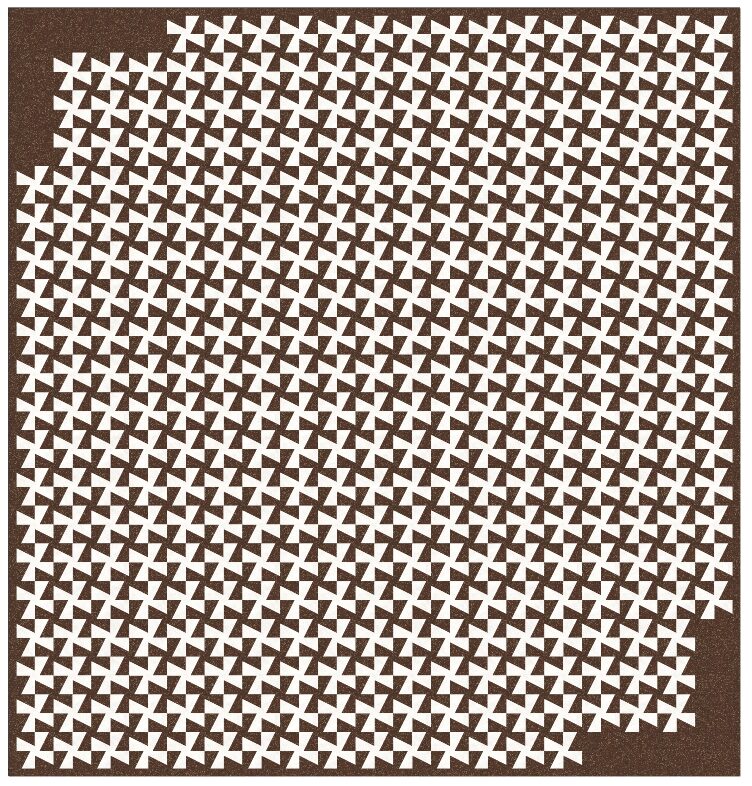Once I had decided to dive into the world of temperature quilts – and had chosen my (gorgeous) fabrics. It was time to decide on a block that would be used to “document” the high and low temperatures for each and every day for an entire year.
Block Choices
[1] Block Complexity: Does it have a lot of pieces? Is it time consuming to make? How many fabrics are needed to create the block? If the block uses too many other fabrics – the effect of the High/Low temperatures fades away.
As I researched ideas (there are a few Facebook group devoted to temperature quilts) – I realized that there are several things to consider when deciding on a block to use for the quilt.
[2] Block Repeat: Does the block look good set in rows right next to each other?
[3] Block Size: Tiny blocks can be challenging to make – but would create a fun wall hanging size project. Larger blocks can make up to a large bed quilt size. Consider that you will be making 365 (or 366) of them. Is the block you’ve selected – one you will enjoy making that many of?
[4] Quilt Size: Temperature Quilts can be created in any size. Here are some typical block sizes for each project size. A border may be necessary to achieve the larger bed quilt sizes.
- Wheelchair or Wall Quilt: 1″ Blocks
- Crib: 1-1/2″ Blocks
- Throw: 2″ – 2-1/2″ Blocks
- Twin: 3″ – 3-1/2″ Blocks
- Queen: 5-1/2″ Blocks
- King: 6″ – 6-1/2″ Blocks
[5] Layout: The 365 / 366 blocks do not evenly organize themselves into an even number of rows. There will be some “blank” space that will need to be worked into the design. Some options for layout:
- Add a “spacer” block at the beginning of each week / month.
- Set the rows in rows – to fit whatever size project you are making. Add the “space blocks at the beginning and end of the blocks you have created and set into rows.. That’s what I’m doing for my quilt.
Some Options I Considered
The original quilt that inspired this adventure featured tiny houses. I’ve already made a couple of quilts featuring houses (at least) so I want to do something different with this quilt. Here are some of the blocks I considered.

The Quarter Square Triangle Block. Uses 4 pieces including 2 that become the background – making the high and Low temperature fabrics pop.

The Half Square Triangle Block. Uses 2 fabrics – easy to make. Looks striking set in rows.

The Drunkard’s Path Block. This one also uses 2 fabrics. The curved setting does increase the degree of difficulty – but it also looks nice set in rows.

Pinwheel Variation Block. Another block using 2 colors. It could also be made using 3 colors – adding in a background fabric. This would make the stars pop.

Window Variation Block. This one uses three fabrics. This one was my first choice with the center being the background, the lower frame being the low temperature and the upper frame as the high temperature.
My Final Choice
It was decided – I was going to use the Window Variation block. I loved how it looked set into rows and it created a dramatic look. Then I made a sample block. It was beautiful. The problem – I couldn’t see myself taking that much time to make 365 more of them.
Lesson learned: Make a sample block before you commit to the entire project.
I kept going back to the Pinwheel Variation block. Something about that block – using 3 fabrics was speaking to me. The problem – that’s a lot of pieces in each block – and a lot of blocks to make. I thought about making that many of them – and kept searching.
Here’s the block I ultimately decided on: It’s still a Pinwheel Variation Block but this one uses a template – every shape is the same.

This block makes it possible for me to cut stacks of the background fabric in the same shape and match that up with which ever fabric color represents the temperature I am documenting in my quilt. I’m using the top part of the block to represent the high temperatures and the bottom to represent the low temperatures. It will be interesting to see how the colors play together once the rows are created and sewn together.
The quilt will be set into 20 rows of 19 block (or spacers) in each row. As you can see from the diagram below – I’ve aded the “spacer areas” – in the upper left and lower right of the quilt.

Are you ready to jump in and get started on your own temperature quilt?
More Info About Making a Temperature Quilt
Recording the Entire Year in a Temperature Quilt
Choosing Fabrics for a Temperature Quilt
